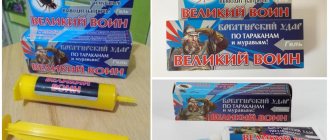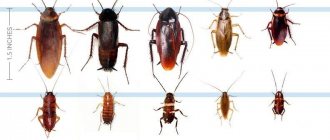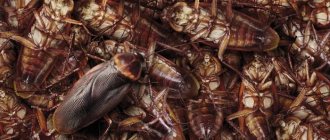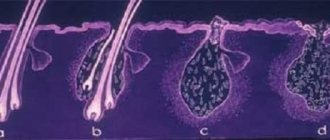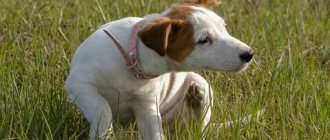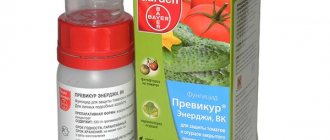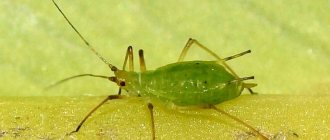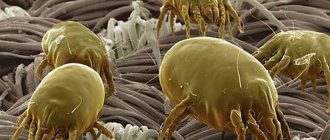Good afternoon, experienced and novice poultry farmers! Today we will tell you how to get rid of feather eaters in chickens and what to do. It is easy to determine that lice eaters or feather eaters have appeared in the chicken coop - the poultry is actively losing feathers, although the time for molting has not yet arrived, and is constantly itching. And the behavior of usually calm and balanced chickens changes dramatically - it’s as if they cannot find a place for themselves in the chicken coop and on the run.
These small-sized parasites, settling on the body of the bird house inhabitants, feed on their down, feathers and skin particles, causing great harm to the birds. But there are many effective ways to combat these skin parasites, thanks to which you can get rid of them quickly. How to deal with periodontal beetles will be discussed below.
Description of feeding in chickens
These parasites live on the skin of poultry and feed on skin particles and the base of feathers. A distinctive feature of feather eaters is that they can go without food for a long period of time, and sudden changes in temperature do not affect their vital functions.
Adults can reach a length of up to 2 mm, their body shape is oval. These parasites have 3 legs with claws, with which they cling to the skin and feathers of birds, moving from place to place. In addition to plumage, feather eaters can feed on ichor secreted from wounds on the skin of chickens.
How dangerous are pereaters?
If treatment is not timely, you will have to face the following consequences of mallophagosis:
- a decrease in the productivity of laying hens by more than 10% as a result of weakening of their body;
- slow weight gain in chickens and broilers;
- the onset of sexual maturity of chickens later than expected;
- infection of birds with infectious diseases due to the appearance of open areas on the skin, which become covered with small wounds and become foci of penetration of skin infections;
- death of poultry;
- infection of the entire flock with a parasitic infection (parasites need the constant presence of the host, so they crawl from sick chickens to the feathers of healthy individuals).
For ornamental chickens, the presence of feather eaters is also unpleasant from an aesthetic point of view, since they disrupt the beauty of the plumage and lead to baldness of individual parts of the body. Feathers affected by parasites gradually fade and lose their shine.
What do feather eaters and lice eaters look like?
These parasites can cause the following harm to chickens:
- reduce egg and meat productivity. At the same time, the hen reduces egg production by approximately 9-11%;
- weight gain in young animals decreases, puberty may occur much later than expected;
- In decorative breeds of chickens, the plumage is damaged, it becomes dull and falls out en masse. As a result, individuals lose their decorative properties;
- Mallophagosis (damage from the feather eater) is accompanied by itching; as a result, chickens scratch their delicate skin until there is blood and wounds into which pathogenic microorganisms can enter.
Chickens can become infected in the following ways:
- from other individuals that have feather eaters on their plumage when they “bathe” in ash baths;
- from wild birds that fly into a private yard;
- the parasite was carried by the owner on clothes or shoes if he went into a chicken coop or on a paddock where there are sick chickens.
Harm and danger
Photo of what the pest looks like:
The most obvious harm that an insect can cause is to reduce the productivity of chickens. The ability to lay eggs drops by a little more than 10%.
Pests have a detrimental effect on the body of both adult and young birds.
Young animals gain weight very poorly, and puberty occurs later than expected.
If a bird breeder keeps decorative types of chickens, then their aesthetic appearance is lost, since the feather eater damages the base of the feathers, they become dull and fall off.
The disease mallophagosis causes itching, causing the bird to scratch its skin until it reaches wounds that can become infected.
Causes of mallophagosis
The main reasons why this disease occurs, experts include:
- the chicken coop is too small for a flock of poultry, there is too much crowding of birds;
- the premises are not kept clean - the owners rarely clean and disinfect;
- the diet is not properly balanced;
- no necessary fertilizing;
- Preventative work is not carried out.
Some practical tips for farmers
There are also several universal tips that every person who wants to prevent re-infection of birds should heed. The list below shows only the most common of them.
- Don't limit yourself to inspecting the bird at the time of purchase. Try keeping new individuals separate from the rest by creating a quarantine area. Such actions will help prevent infection of the entire livestock in the event that one of the individuals is nevertheless affected by the chicken feather eater.
- Carry out preventive treatment of premises at least twice a year. Pay special attention to the spring and summer seasons, since at this time of year the beetle reproduces with particular intensity. For prevention, you can use any folk or pharmacy remedy.
- Try to limit your chickens' contact with wild birds, as this can lead to parasite infestation. To do this, you can install nets on the windows in the chicken coop and make closed enclosures for chickens to walk around. You should be especially careful around crows and pigeons.
Remember that if the infection reaches a critical stage (pecking of the surface), then consultation with a specialist will be strictly mandatory. Otherwise, you risk losing your entire livestock.
Symptoms of overeating in chickens
According to statistics, cockerels are less clean than hens - they clean their feathers less often, so parasites multiply faster on their skin.
To prevent bird eaters from affecting the entire herd, it is necessary to immediately begin fighting them if the following symptoms are noticed in individual individuals:
- the chickens feel worse, become more lethargic, sleepy, as the constant itching bothers them greatly;
- the plumage of chickens also suffers - the feathers fade and fall out, microholes are noticeable at the base of the feathers;
- chickens constantly take dust baths, trying to get rid of parasites, and often clean their feathers and down. This symptom indicates that the disease is at an early stage, in which case timely control measures can save other birds from infection;
- appetite worsens, birds gain weight worse;
- bald spots in plumage;
- discharge from the eyes, which dry out and become crusty;
- small wounds are visible on bald spots;
- egg production of laying hens is reduced.
Poultry infection routes
There are several known routes of infection:
- From an already sick chicken while taking a dust bath.
- From wild birds flying into the yard.
- The insect can be brought by the owner himself on his clothes or shoes from another pen where infected chickens lived.
Distribution of the down-eater
Knowing in advance about the specifics of the spread of the feather eater, you can prevent mass disease in chickens. This insect is distinguished by its increased fertility; in less than a month, the female can lay a huge number of eggs.
Beetles choose warm and humid places for breeding. Females place their eggs at the base of the feathers or down; they are difficult to remove due to the dense adhesive base covering the egg.
From the laid eggs a larva emerges, which after three molts becomes a sexually mature individual. To do this, the pest needs to stay on the feathers for no more than three days.
Outside the body, the insect cannot exist for more than 4 days, so the feather eater spends almost the entire time of its existence on the body of the chicken.
Statistically, roosters clean their feathers less, which is why they tend to have more insects. The spread of the lice beetle is facilitated by untimely cleaning of the chicken coop and dampness.
Be sure to read:
Cockfighting, or all about fighting breeds of chickens
How to get rid of feather eaters in chickens at home
Effective methods of fighting the beetle further.
The earlier the disease is diagnosed, the fewer birds will be infected, and it is easier and faster to fight a small number of parasites.
The most effective methods of control:
- using chemicals;
- folk ways.
Chemical preparations can negatively affect the health of poultry, so they are used only when there are too many feather eaters and traditional methods become ineffective.
If there are few parasites, then it is better to use traditional methods of control.
Chemical repellents
How to get rid of feather eaters in chickens at home using chemicals. You should know the basic chemicals that can be used to combat these parasites in chickens:
Leopard, Neotomazan - although these drugs are intended for domestic animals, they are highly effective in the fight against pereaters;
Frontile, Stronghold - available in the form of drops, used when there is a small amount of these parasites on the body of chickens. It is enough to apply the drug along the bird’s spine;
Butox is a liquid that is diluted in water according to the instructions and applied to the plumage from a spray bottle. This solution can be used to disinfect a poultry house, from which all livestock have been previously removed;
Insectal is a powder that needs to be rubbed into the skin of sick birds. You should adhere to the dosage indicated in the instructions for use;
Arpalit - produced in the form of an aerosol, which is sprayed onto the plumage of young animals and adults;
Nyuda - comes in the form of a spray. Although the drug is intended to kill lice in humans, it also copes with lice. The toxicity of this spray is lower than that of other drugs described above.
Before using the above products, you should read the instructions for their use and follow all the precautions indicated in the instructions.
Wormwood for ticks
Bitter herb will also help get rid of almost any type of parasite. The most important thing is to prepare the folk remedy correctly. To do this, you can use two methods at once: dry and wet. Both of them are equally effective, so the farmer has the right to choose which one is more suitable, based on individual preferences, as well as the degree of infection of the livestock.
With the dry method, you must follow a certain algorithm of actions:
- We collect several kilograms of wormwood and leave it to dry.
- We crush the dry grass into small pieces or even grind it into powder.
- Add the product to the ash in a ratio of 1:10 (a kilogram of wormwood per 10 ash).
- Spread the mixture around the chicken coop or poultry yard.
As for the wet method, it involves the use of wormwood infusion:
- We take two large bunches of freshly picked plants and put them in a saucepan.
- Pour the grass with 10 liters of boiling water cooled to 90°.
- Close the product with a lid and leave to infuse. within 3-4 hours.
- We filter the solution and treat the fluff and skin with it.
Every farmer should understand that wormwood will cause a strong burning sensation in chickens, therefore it is recommended to treat the disease in such ways only in the early stages of its manifestation. If the bird is already suffering from a large number of skin lesions, then using a tincture or dry herb may worsen the condition. Therefore, use these techniques at your own peril and risk, being careful not to touch sore areas and pecking areas.
Poultry house disinfection
How to get rid of feather eaters in chickens and in the chicken coop? Simultaneously with the destruction of feather eaters in poultry, it is imperative to completely disinfect the chicken coop. Wooden structures should be treated with special preparations, and iron parts should be burned with a blowtorch.
Insecticides for disinfecting a chicken coop:
- 10% solution of Pyrethrum;
- 5% solution of Karbofos;
- Butox - diluted with water in the ratio - 1 ml of the drug requires 4 liters of water.
After complete treatment of the poultry house, birds treated for periodontal disease can be released into the premises only after a couple of days.
Old litter is also removed and destroyed, drinking bowls and feeders are disinfected.
You should know! Dichlorvos cannot be used to disinfect a chicken coop - its vapors are very toxic and can harm weakened chickens.
Camomile tea
Another remedy that is very popular. Unlike wormwood, chamomile will not cause discomfort to the bird, and it can be found in almost every yard. However, it should be noted that in the later stages of the development of the disease, chamomile infusion will be of little use, since the parasites will multiply at tremendous speed. In other cases, you can prepare the product using the algorithm described below.
- Take two large bunches of freshly picked grass.
- Pour 10 liters of boiling water over chamomile.
- Let the product sit for 5 hours.
- Thoroughly strain the water from the grass.
The resulting tincture must be used to treat poultry feathers. This is best done using a spray bottle, holding the tool at a distance of 20-30 centimeters from the chicken. The following areas should be subjected to special treatment: wings, tail, neck - this is where most of the parasites are concentrated. The procedure must be carried out at intervals of 2-3 days even after the tick disappears.
How to get rid of feather eaters in chickens using folk remedies
The advantage of folk remedies in the fight against periodontal beetles is that, despite their effectiveness, folk recipes do not contain toxic substances, so they can be used to treat young animals. How to get rid of feather eaters in chickens at home using folk remedies?
Ash baths
Wood ash is one of the most effective drugs in the fight against parasites that can appear in the plumage of chickens and other poultry. To prepare such a product, take equal parts of river sand and ash, mix thoroughly and fill the baths.
Some farmers add Chlorophos to such a bath, the volume of which should be no more than 2% of the total amount of sand-ash mixture.
Chickens enjoy taking such baths, and at the same time clean their feathers of parasites.
Herbs
The aroma of many herbs repels not only the bird eater, but also other parasites. These herbs include:
- tansy;
- chamomile;
- wild rosemary;
- juniper;
- sagebrush;
- rosemary.
Such herbs are collected in bunches and hung around the entire perimeter of the poultry house. As a result, the beetle and other parasites leave such a room. Typically, the stock of such herbs is replenished during the summer so that the bouquets of such flowers last throughout the winter.
Kerosene
How to get rid of feather eaters from chickens with kerosene at home. Kerosene is another effective remedy against parasites. It should be diluted in water, and the resulting solution should be rubbed into the feathers and skin of chickens. Similar treatment is carried out daily until the last feathers die.
If the bird is too seriously affected, you can use the following composition: mix kerosene, vinegar and water in a ratio of 0.25:1:2. With the help of such a solution, it is possible to quickly destroy all parasites.
What kind of parasites are these?
The periodontal beetle, also known as the "chicken louse" or "chicken mite", is a small parasite that can be recognized by the following characteristics:
- body dimensions do not exceed 2-3 mm;
- the head is triangular in shape and protrudes above the body;
- the oral organs are presented in the form of a gnawing apparatus;
- body shape is flat and slightly elongated;
- the hard shell that covers the body is light brown with a hint of yellow;
- the body is divided into several segments, between which stripes of a dark shade can be seen;
- wings are missing.
Such parasitic organisms settle on the body of birds and live in their feather cover, holding on to it with the help of a jaw and three pairs of paws. Because of them, chickens become irritable because they feel severe itching. To cope with it, they begin to itch, pull out feathers and peck at each other.
This leads to loss of plumage in chickens, increased irritability and the appearance of small abrasions on the skin, which makes the environment more favorable for the development of parasites. In veterinary medicine, such a disease is called mallophagosis, so pereaters are also known as mallophages (down-eaters).
It should be noted that, unlike blood-sucking parasites, such parasites do not feed on the blood of chickens. The diet of pereaters includes:
- fluff;
- feathers;
- particles of dead skin;
- ichor, which is released from places of pecking and scratching of the skin.
The fertility of these parasites is quite high: at a temperature of 25-30°C and a humidity of 70-80%, one female a day can lay up to 10 eggs, attaching them to the feathers or down of chickens. The development cycle from egg to adult takes about 3-4 weeks.
The larvae usually emerge from the eggs 6-18 days after they are laid. Then they go through 3 stages of molting, each of which takes 12-18 days. After this, the parasites become adults, whose lifespan in the external environment is 6 days, and on the host’s body - 30 days.
One chicken is home to up to 10,000 parasites, which can migrate into bird bedding, equipment or flooring. It is believed that one sick chicken can infect the entire chicken coop with mallophagosis within a week. Young animals are most susceptible to the effects of pereaters.
Preventive actions
A major role in the fight against parasites is played by the implementation of all preventive measures:
- regularly change the floor covering, remove chicken droppings every two days;
- Once a month, thoroughly disinfect the chicken coop, including drinking bowls, feeders and tools;
- hang bunches of herbs around the perimeter of the poultry house, the aroma of which cannot be tolerated by parasites, and change them regularly;
- you need to monitor the behavior of birds, this allows you to recognize the onset of the disease in time;
- When it is confirmed that birds are infected with a bird eater, it is necessary to immediately begin fighting it, as well as disinfect the premises;
- make sure that chickens do not have contact with wild birds flying in for a walk;
- if the owner entered another room with poultry, it is necessary to change clothes, shoes, and wash hands.
Compliance with preventive measures allows you to avoid mass destruction of the chicken population by the feather eater or lice eater. The main thing is to keep the house clean and ventilate it regularly.
We told you how to get rid of feather eaters in chickens. Share useful material with your like-minded people and friends on social networks.
Subscribe to the site's newsletter. You'll be among the first to know the latest chicken news.
See you!
Did you like our tips? Share with friends on social media. networks!
Symptoms of appearance
Mallophagosis can be detected by paying attention to the behavior of chickens. The appearance of parasites will make itself felt with a number of symptoms that are not typical for other diseases.
- Birds are constantly running around, their behavior is restless.
- They eat little or refuse food altogether.
- The plumage is often cleaned.
- They peck themselves, pulling out fluff and feathers.
- Chicks grow more slowly and adults lose weight.
- They began to rush less.
Further the picture gets worse. New signs appear:
- Feathers with the shaft eaten away begin to fall out. Chickens begin to pull out feathers not only from themselves, but also from each other.
- Bare, often inflamed areas of skin appear. Scratching areas are especially visible around the neck, on the tail, and on the inside of the wings.
- The mucous membrane of the eyes becomes inflamed and suppuration appears.
Expert opinion
Firsov Sergey Arkadevich
Poultry farmer
If treatment for mallophagosis is not started on time, the bird will die.
How dangerous is mallophagosis in birds?
It can be extremely difficult to overestimate the degree of negative impact of parasites. That is why, before starting to treat periodism in chickens using folk remedies, you should definitely consult with a qualified specialist, since the disease can develop into a severe stage.
Even at the initial stages of development, the presence of parasites can lead to the fact that laying hens begin to lose their productivity, and meat breeds lose live weight. Due to parasites, poultry can develop a variety of diseases, which sooner or later will lead to a drop in the number of birds.
The problem is especially aggravated with the onset of cold weather, when the bird can simply freeze due to lack of plumage. Even if sick individuals manage to survive the winter, it is far from certain that in the spring they will begin to actively reproduce, since they will experience a feeling of discomfort.
Well, the most dangerous thing about mallophagosis is that it develops at an incredibly high speed. As a rule, it only takes a few weeks for parasites to infect the entire flock, starting with one chicken. That is why it is so important to start timely treatment, using all available and proven means.

